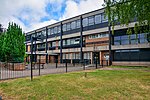Creedy, Sandford
Country houses in DevonHistoric estates in Devon

Creedy is an historic estate in the parish of Sandford, near Crediton in Devon. It is named from its location on the west side of the River Creedy. It was the seat of the Davie family (created Davie baronets in 1641) from about 1600 until the late 20th century. The mansion house on the estate has been called at various times New House, Creedy House, and as presently, Creedy Park. It was first built in about 1600, rebuilt in 1846, burnt down in 1915 and rebuilt 1916–21. It is surrounded by a large park, the boundary of which is enclosed by a stone and brick wall several miles long.
Excerpt from the Wikipedia article Creedy, Sandford (License: CC BY-SA 3.0, Authors, Images).Creedy, Sandford
Higher Road, Mid Devon Sandford
Geographical coordinates (GPS) Address Nearby Places Show on map
Geographical coordinates (GPS)
| Latitude | Longitude |
|---|---|
| N 50.8025 ° | E -3.6584 ° |
Address
Higher Road
EX17 2ES Mid Devon, Sandford
England, United Kingdom
Open on Google Maps







